
方案详情
文
英国石油公司据称考虑用燃烧的办法,清理覆盖在海面上的石油膜,美国EPA针对墨西哥湾石油泄漏燃烧清理作出整套的质量保证采样计划,计划监测密西西比州、亚拉巴马州和佛罗里达州等地石油燃烧后的颗粒物(PM) 及VOCs的环境浓度及在不同天气状况下的浓度特征。本方案是由美国环境保护署和全国有害气体监测网联合进行监测,监测了PM2.5,VOCs,PAH等多项指标,并且根据EPA标准方法进行监测和分析。
方案详情

QUALITY ASSURANCE SAMPLING PLAN FOR BRITISH PETROLEUM OIL SPILL Prepared for U.S. Environmental Protection Agency Prepared in conjunction with: EPA Region 6 EPA Region 4 EPA Environmental Response Team EPA ASPECT CTEH May 2010 1. INTRODUCTION. .3 1.l MONITORING AND SAMPLING STRATEGIES. 1.2 PROJECT TEAM.... 4 1.3 .OVERVIEW OF SAMPLING ACTIVITIES. .5 1.3.1 Data Quality Objectives...... .5 1.3.2 Air Sampling/Monitoring Approach. 5 1.3.3 Air Sampling and Monitoring Program for Oil at Landfall. 5 1.3.4 Particulate Air Monitoring .. 1.3.5 Particulate Air Sampling. .8 1.3.6 VOC Air Monitoring... 8 1.3.7 Water and Sediment Sampling (Region 6). 1.3.8 Sampling and Field QC Procedures... 10 1.3.9 Investigation-Derived Wastes ....... 1.3.10 Sampling and Sample Handling Procedures.. 11 1.4 SAMPLE MANAGEMENT. .112 1.5 SAMPLE PRESERVATION,CONTAINERS, AND HOLD TIMES. .12 2. ANALYTICAL APPROACH..... ....2-1 2ON-SITE TEDLARBAG VOC ANALYSIS3.22 OFF-SITE VOC ANALYSIS. 2 2 DATA VALIDATION..2 3. QUALITY ASSURANCE. ....3-1 3SAMPLE CUSTODY PROCEDURES. 3-13.PROJECTDOCUMENTATION.o... .3-2 3.2.1 Field Documentation..... 3.2.2 Report Preparation ...... 1. INTRODUCTION The British Petroleum Oil spill source is located approximately 52 miles southeast of Venice,Plaquemines Parish, Louisiana, (28.73667°N, -88.38722°W). The source is a leaking production well aswell as a release of diesel fuel caused by damage from the sinking of the Transocean Deepwater Horizondrill rig at BP Site Mississippi Canyon 252. The current spill is estimated to be approximately 80 mileseast to west and 42 miles north to south in size. The spill is affected by wind and wave action, which iscurrently keeping the spill offshore; however, forecasted weather conditions in the coming days ispredicted to push the spill towards the southeast Louisiana coastline. Through coordination with theUnited States Coast Guard (USCG), British Petroleum PLC (BP), the Responsible Party, through their OilSpill Response Organization (OSRO) contractors are planning controlled burns of the oil in sectionswhile weather conditions are acceptable. The following groups have jointly prepared this Quality Assurance Sampling Plan (QASP). Environmental Protection Agency Region 6 Region 4 Environmental Response Team (ERT), National Decontamination Team (NDT) Airborne Spectral Photometric Environmental CollectionTechnology (ASPECT) Contractors ERT’s contractor, Scientific, Engineering, Response and Analytical Services (SERAS), Retional Contractors, Superfund Technical Assessment and Response Team (START), British Petroleum’s contractor, Center for Toxicology and Environmental Health (CTEH) The purpose of this QASP is to describe the technical scope of work to be completed as part of thisemergency response. The objective of this study is to conduct ambient air monitoring and sampling toassess the environmental and human health impact of the in-situ burn process and impacts from thevolatilization of the crude oil, in addition to surface water and sediment samplin1g. In the event of futureburns and depending on where the oil comes ashore, additional air, surface water, and sedimentmonitoring plans will need to be generated to include affected sites. 1.1 MONITORING AND SAMPLING STRATEGIES EPA Region 4: :EPA Region 4 will conduct monitoring at several locations using several methods tomeasure particulate matter (PM) and volatile organic compounds (VOCs) that are expected to be presentas a result of the burn. Affected Region 4 areas where impact is possible include the states of Mississippi,Alabama, and Florida. The Gulf Coast of Region 4 presently contains a robust fixed ambient air monitoring network of siteswhich are operated and maintained by state and local operators from the respective states..These sitesmbnitor fr a large array of ambient pollutants including PM2.5. The state monitoring sites froLouisiana border to Panama City operating filter based PM2.5 samplers will sample on a 1 in 3 day sampling schedule. As conditions warrant, the PM2.5 filter based sampling may be increased to every daysampling. Five of these existing sites close to Venice, Louisiana will be augmented with additional monitoringequipment including continuous PM2.5 samplers and VOC samplers. The sites that will be augmentedinclude: Waveland, Mississippi; Gulfport, Mississippi; Fairhope, Alabama; Pensacola, Florida; andPanama City, Florida. In addition to the ambient monitoring, VOC grab samples will be conducted asrequested or necessary according to meteorological patterns. There are two National Air Toxics Trends Sites (NATTS) stations which are located in the Tampa Bayarea, in the vicinity of the spill, which could be requested to provide additional monitoring data byincreasing their station’s sampling frequency. One is located in Pinellas County, and the other is locatedin Hillsborough County, both monitoring on a 1 in 3 day schedule. These two sites operate an array of airtoxics monitors including VOCs, and have laboratory capability for analysis of several air toxicscomponents. EPA Region 6: EPA Region 6 will assess the impacts of the BP Oil Spill on the air, sediment and waterquality of far southeast Louisiana, specifically the area around Venice, Duvic and Fort Jackson,Plaquemines Parish and an area between Alluvial City and Chalmette in St. Bernard Parish, Louisiana.EPA will utilize PQ200 air samplers, DataRAM DR-4000 particulate monitors, Tedlar bags for VOC grabsamples and AreaRAE air monitors. Additionally, SUMMA passivated canisters (SUMMAs) with flowcontrollers will be used to sample for VOCs. For water and sediment sampling, EPA will utilize multi-parameter water quality instruments. Air samples will be collected once every 24 hours by the PQ200 and analyzed for concentrations ofparticulates 2.5 microns and smaller. Grab samples for VOCs will be collected using Tedlar bags and lowflow pumps, and analyzed using EPA/ERT TAGA bus instruments. The SUMMA" canisters will collectsamples for VOCs every 8 hours and will be analyzed by method TO-15A. DataRAMs will be used inreal-time monitoring of the PM-2.5 particulate levels and AreaRAEs to monitor for VOCs. ERT/SERAS:: Air monitoring will be conducted along the coastlines of EPA Regions 4 and 6..TheTAGA Mobile Laboratories will provide mobile monitoring for the selected compounds of interest (i.e.,benzene, toluene, ethylbenzene and xylenes). ERT/SERAS will also provide quick turnaround analysis ofselected compounds for samples collected in Tedlar bags. NDT/ASPECT: The ASPECT airborne monitoring system collects data regarding emissions andtracking releases. The goal of this mission is to collect data over the source area (sunken rig) to establisha chemical fingerprint of the release source, collect data over the site of an in-situ burn of contained oil toprovide information on burn effectiveness, and a higher altitude photo reconnaissance to cover a broaderarea of the oil release. 1.2 PROJECT TEAM The Project Team will be divided into multiple locations and multiple teams based upon site conditionsand operations. As the meteorological and operational situations change, sampling and monitoring teamsand operations will adapt, based upon direction from the Unified Command. EPA Federal On-SceneCoordinators (OSCs) and START personnel from Region 6 will have responsibility for sampling andmonitoring in Louisiana, and Texas if necessary. EPA OSCs and START personnel from EPA Region 4will have responsibility for sampling and monitoring of the plume in Mississippi, Alabama and Florida asnecessary. EPA ERT members will assist EPA Region 6 and 4 with sampling and data collection and analysis as needed.EPA will coordinate with the Unified Command through EPA OSCs located inHouma, Louisiana and the USCG Sector Mobile. The ERT/SERAS project team will consist of four persons for each TAGA mobile laboratory (driver,TAGA Operator, GC/MS Operator and GIS Data Reduction Specialist) as well as an EPA/ERT memberfor each 12-hour shift. EPA/ERT members will assist EPA Regions 6 and 4 with sampling, datacollection and analysis, as needed. The EPA NDT will provide over-flight operations over the affected areas utilizing the ASPECT airbornemonitoring system. CTEH, a contractor for British Petroleum, responded in support of site operations for the BritishPetroleum Oil Spill on Sunday, April 25, 2010. CTEH is providing air monitoring, air sampling, andtoxicology support along the Gulf coast from Pensacola, Florida to Venice, Louisiana to address publichealth and worker health and safety concerns resulting from the crude oil spill. 1.3 OVERVIEW OF SAMPLING ACTIVITIES 1.3.1 Data Quality Objectives The objective of air monitoring and sampling will be to confirm the presence of particulates (2.5 micronsand smaller) and VOCs in air resulting from the off shore in-situ burn, and from possible air qualityimpacts due to the oil spill coming on-shore. 1.3.2 Air Sampling/Monitoring Approach Air monitoring and sampling will be conducted in general accordance with the EPA guidelines andstandard industry practices, included the DRAFT START Emergency Response Air Quality AssuranceSampling Plan (QASP) and with START Standard Operating Procedures (SOPs). The Region 4 sampleswill be collected following EPA Region 4 Science and Ecosystem Support Division (SESD) SOPs. InRegion 6, a field communication protocol based upon VOC readings using the real-time data from aMultiRAE or AreaRAE PID will be implemented. START will collect Benzene or Toluene colorimetrictube samples for confirmatory air monitoring readings. This will occur when a total VOC reading of 10.0ppm or higher is recorded. After positive confirmatory monitoring, Region 6 field teams will contact thefield operations OSC to notify them of the elevated VOC monitoring reading, which will then be passedonto to EPA representatives at Unified Command. 1.3.3 Air Sampling and Monitoring Program for Oil at Landfall The air sampling and monitoring program for British Petroleum Oil Spill landfall operations will bemodified as necessary to adjust for wind direction and landfall location. In summary, the program willinclude real-time monitors, aerial flyovers as necessary, real-time speciated VOC sampling for BTEXcompounds using the TAGA and collection of whole air samples using SUMMA canisters and grabsamples using Tedlar bags as identified below: Based upon VOC readings, using the real-time data from a MultiRAE or AreaRAE PIDs, benzene ortoluene colorimetric tubes will be used to take confirmatory air monitoring readings for benzene andtoluene. This will occur when a total VOC reading equal to or greater than 10.0 parts per million (ppm) is recorded. Also, at that time, field teams will contact the field operations OSCs to notify them of theelevated VOC monitoring reading. Additional monitoring techniques have been employed, including butnot limited to: ERT TAGA sampling in downwind shore locations for BTEX and any other appropriatecompounds - available beginning Mid-day April 30; NDT ASPECT if necessary and appropriate for oil spill delineation - Daylight operations, asnecessary, Downwind dataRAM/miniRAM particulate monitors near potentially exposed populations (R6 orR4START); SUMMA@canister capability for 8-hour composite samples for VOCs (R6 or R4 START); Tedlar Bag grab samples for VOCs on odor complaints and as necessary (R6 and R4 START); AreaRae and MultiRae detectors as appropriate for odor complaints (R6 or R4 START); ● Additional elements to be added as required. 1.3.3.1 REGION 4 and REGION6FIXED AIR MONITORING SITES Region 4 and Region 6 will collect air quality data from existing ambient air monitoring sites located onthe Gulf Coast of Mississippi, Alabama and Florida. The sites are described below by location ancmonitored analytes: LOCATION ANALYTE MISSISSIPPIWavelandPM2.5, O3GulfportPM2.5,O3PascagoulaNO2, SO2, O3, PM2.5ALABAMAFairhopePM2.5, O3ChickasawPM10, PM2.5,O3Mobile, Bay Rd.PM2.5, O3Mobile, Telegraph Rd.PM10FLORIDAPensacola, EllysonNO2,SO2, PM2.5, OsPensacola, NASO3Panama City, Cherry St.PM2.5Holmes Co., Tri County Apt.Okaloosa Co., Lovejoy Rd.Santa Rosa Co., WoodlawnLOUISIANAKenner SiteVOCChalmette VistaVOC As part of the National Air Toxics Trends Stations (NATTS), Pinellas and Hillsborough Counties,Florida, presently conduct monitoring for air toxics. These sites operate on a one-in-six day schedule, andcollection frequency may be modified to support the spill response monitoring efforts. Data for the gaseous pollutants, Nitrogen Dioxide (NO2) and Sulfur Dioxide (SO2) will be collectedcontinuously at the monitoring sites specified above. Additionally, ozone (O3) data will be observedbecause hydrocarbons can interfere with ozone detection; therefore unusual increasing levels of“ozone"can potentially be a reasonable surrogate for the presence of hydrocarbons. For short-term data collection, Region 4 will rely on SESD for VOC sampling and the states for PM2.5monitoring. Sampling and monitoring support may also be supplied by the Emergency Response andRemoval Branch (ERRB) OSCs with START contractors. The state and local agencies and/or contactorsare expected to provide long term monitoring and sampling support in operation of the monitoringnetwork. EPA ASPECT aerial flyovers will take place during in-situ burn operations.The ASPECT sensors andmonitors will collect particulate and combustion product data. 1.3.3.2 Mobile Air Monitoring Using the ERT Trace Atmospheric Gas Analyzer(TAGA) TAGA monitoring will be conducted using draft SERAS SOP #1711, Trace Atmospheric Gas Analyzer(TAGA) Ile.. The ECA TAGA IIe is based upon the Perkin-Elmer API 365 MS/MS and is a direct airmonitoring instrument capable of detecting, in real time, trace levels of many organic compounds inambient air.The TAGA employs a triple quadrupole MS/MS to differentiate and quantitate targetcompounds. At the beginning of each TAGA monitoring day, a gas mixture containing the target analytes of concernwill be introduced by a mass flow controller into the sample air flow (SAF).. The gas mixture isintroduced into the SAF, and the tuning parameters for the first quadrupole and the third quadrupole areoptimized for sensitivity and mass assignment. The TAGA will be calibrated for the target compounds atthe beginning and end of the monitoring day; the detection and quantitation limits for each day will becalculated, and the intermediate response factors will also be calculated daily. 1.3.4 Particulate Air Monitoring REGION 4 Air Particulate PM 2.5 Monitoring: EPA will monitor PM2.5 concentrations at the selected4 fixed sites using continuous PM2.5 samplers. The samplers used will be MetOne E-BAM PM and theMetOne BAM 1020 which use beta attenuation technology to measure PM concentrations on acontinuous basis.;. Three of the selected fixed sites, Gulfport, Mississippi, Panama City, Florida andPensacola, Florida already contain continuous PM samplers whose data can be used for monitoring theburn event..These continuous samplers have a distinct advantage over filter based methods in that thedata can be transmitted directly to a central location via telephone line or satellite link. The selected sitesare part of the regular ambient air monitoring network and have been approved by EPA Region 4 asmeeting 40 CFR Part 58, Appendix E sitting criteria for ambient air monitoring. Additional portablePM2.5 air monitors may be used to identify plumes in real-time to identify pollutant plumes. This mayinclude the use ofDataRAMs or similar equipment. REGION 6 Air Particulate Monitoring: START will conduct baseline particulate (dust) monitoringdownwind of the in-situ burn using DataRAM instruments over a 24-hour period, during burningactivities. The DataRAM instrument is capable of data logging, and the results will be logged no lessthan every 5 minutes and downloaded to a computer at the end of each operating period. Air monitors will be collocated with PQ200 air samplers, which will be selected using local meteorological data, dailyobservations, and locations of burning activities. 1.3.5 Particulate Air Sampling REGION 4 Air Particulate PM 2.5 Sampling: Eight of the state operated monitoring sites on the GulfCoast currently sample for PM2.5 using the filter-based method sampling for 24 hours on a 1 in 3 dayschedule. As conditions warrant, the PM2.5 filter based sampling may be increased to every day sampling. REGION 6 Air Particulate Sampling: START will deploy PQ200 air samplers equipped with a filtercassette to measure PM2.5 concentrations in ambient air at three locations in Plaquemines Parish and threelocations in St. Bernard, Louisiana. The samplers will be set up at the pre-determined sampling locationsthat will be selected using local meteorological data, daily observations, and distance from sources ofinterference, and locations of burning activities. Prior to use, START will calibrate the samplers with therepresentative sampling media to verify correct flow rates. Meteorological conditions will be documentedat each sample location when each sample period begins and ends. START will collect one 24-hour airPM2.5 samples at each station for the duration of the in-situ burn or as directed by an EPA OSC. 1.3.6 VOC Air Monitoring REGION 4 and REGION 6 VOC TEMPORARY MONITORING STATIONS: ERRB will mobilizeair monitoring teams to deploy EPA Region 4 AreaRAEs along the coastline; the teams will each consistof one OSC and several START personnel. Additional AreaRAE resources may be deployed from ERTand will be maintained by ERT personnel and contractors.The placement of the temporary stationlocations will be selected based on real-time plume progression, forecasted weather conditions,population centers and geographical areas that will augment the fixed monitoring stations according tospatial gaps.Additional portable VOC air monitors may be used to identify plumes in real-time toidentify pollutant plumes. In addition, grab samples will be collected utilizing either Tedlar bags thatwill be manually transported to the ERT TAGA mobile laboratory, or SUMMA canisters that will beshipped to a contract laboratory for analysis. REGION 4 VOC Composite Sampling: VOC composite sampling will be conducted daily at the 5selected sites: Waveland, Mississippi, Gulfport, Mississippi, Fairhope, Alabama, Pensacola, Florida, andPanama City, Florida using evacuated six-liter (L) SUMMA canisters over a period of 24 hours. In thebeginning phase of the study, the VOC samples will be analyzed by the SESD laboratory using the SESDmodified TO-15 method. Air toxics data from canisters will require 3 to 4 days turnaround time foranalysis from the laboratory. It is expected that as the study progresses the continued analysis of theseVOC samples will be conducted by a contract laboratory. For quality assurance, duplicate samples willbe collected at one monitoring site by placing an identical apparatus next to the primary, with the sampleinlets within six inches of each other. REGION 4 VOC Grab Sampling: VOC grab sampling will be conducted as requested or necessaryaccording to meteorological patterns using evacuated six-L SUMMA canisters or Tedlar bags over aperiod of approximately 5 minutes without the use of a flow control device. The VOC grab samplescollected in the SUMMA canisters will be analyzed by the SESD laboratory using the SESD modifiedTO-15 method. The grab samples collected in the Tedlar@ bags will be analyzed by the ERT TAGAmobile laboratory if possible. It is expected that the VOC grab samples collected in Tedlar bags andanalyzed by the TAGA laboratory would be completed in a matter of hours after collection. It is expected that as the study progresses the continued analysis of these VOC samples will be conducted by an outsidelaboratory. REGION 6 VOC Air Sampling: START will also collect three 8-hour air samples using a SUMMAcanister with a flow controller at each air monitoring location. The SUMMA canister will be mountedand secured no less than one meter from the ground. The flow controllers will be calibrated and checkedfor accuracy by the laboratory prior to sampling, and between each sampling run. Additional VOC grabsamples will be collected using 1-L Tedlar bags each being allowed to collect ambient air using a low-flow air pump (SKC or equivalent) for approximately 10-15 seconds. These Tedlar bags will be held andanalyzed for VOCs through method TO-15 by an EPA/ERT TAGA Mobile Laboratory, two of which arecurrently staged in the operational area. 1.3.7 Water and Sediment Sampling (Region 6) Sediment samples will be collected. The exact number and locations of the samples will be determinedby the EPA OSC and START Project Team Leader (PTL). Initially, in Region 6, samples will becollected within critical target regions in Louisiana water quality sub-segments 070401,070601, 042209,021001, and 042001. Initially samples will be collected from impacted areas and also un-impacted areasto attempt to get data on the impacts and background areas. Sampling points, as a general rule, will belocated within approximately 100 feet of ecologically sensitive areas. The sampling points will haveadequate spatial separation of at least five miles to achieve even representation across the impacted areas.Frequency of the sampling will be determined by EPA OSCs in consultation with Unified Command.The sediment samples will be submitted to a qualified subcontracted commercial laboratory for thefollowing analyses: mTarget Compound List Volatile Organic Compounds (TCL VOCs) by SW-846 Method8260B, TCL Semi-volatile Compounds (SVOCs) by SW-846 Method 8270D. ■ Target Analyte List (TAL) Metals by SW-846 Method 6010C. Mercury by SW-846 Method 7471. Total Petroleum Hydrocarbons - Gasoline Range Organics (TPH GRO) by SW-846 Method8015B. Total Petroleum Hydrocarbons -Diesel and Oil Range Organics (TPH DRO/ORO) by SW-846 Method 8015B. Polynuclear Aromatic Hydrocarbons (PAH) by SW-846 Method 8270D SIM. Laboratory-specific analyte lists and reporting limits will be included as received from the laboratories.Deviations from the sample locations will be due to new observations made prior to sampling,information obtained in the field that warrants an altered sampling point, difficulty in sample collection,or limited access.The EPA OSC will be notified, and concurrence will be obtained should significantdeviations from the planned sampling points be proposed. Details regarding deviations of the QASP willbe documented in the site logbook. START will collect surface water samples as part of the response. The exact number of samples andlocations of the samples will be decided by the EPA OSC and START PTL. Surface water samples willbe submitted to a qualified subcontracted commercial laboratory for the following analyses: TCL VOCs by SW-846 Method 8260B. TCL SVOCs by SW-846 Method 8270D. TAL Metals by SW-846 Method 6010C. Mercury by SW-846 Method 7470. ■ TPH GRO by SW-846 Method 8015B. TPH DRO/ORO by SW-846 Method 8015B. PAH by SW-846 Method 8270D SIM. The laboratory-specific analyte list and reporting limits will be included in the QASP when received. 1.3.8 Sampling and Field QC Procedures Samples will be collected using equipment and procedures appropriate to the matrix, parameters, andsampling objectives.The volume of the collected sample will be sufficient to perform the analysisrequested. Samples will be stored in the proper types of containers and preserved in a manner for theanalysis to be performed per laboratory guidelines. Dedicated sampling equipment, sample containers, and PPE will be maintained in a clean, segregatedarea. It is anticipated that each sample will be collected with dedicated sampling equipment and placeddirectly onto the laboratory supplied glass fibre filters. Personnel responsible for sampling will changegloves between each sample collection/handling activity. Each sample will be assigned a uniqueidentification number and assembled and catalogued prior to shipping to the designated laboratory.SUMMA canisters will be handled per laboratory and manufacturers’guidance, observing safe andeffective collection and preservation of the data. START will collect field duplicate samples of air samples, both filters and canisters, and prepare filterblanks as needed during the removal action..(QA/QC samples will be collected according to thefollowing: Blind field collocated air samples will be collected during sampling activities at locationsselected by the EPA OSC and START PTL. The data obtained from these samples will beused to assist in the quality assurance of the sampling procedures and laboratory analyticaldata by allowing an evaluation of reproducibility of results. Efforts will be made to collectduplicate samples in locations where there is visual evidence of contamination or wherecontamination is suspected. Blind field collocated samples will be collected at the rate of oneduplicate for every 10 samples collected. Filter blanks will be prepared by analyzing a laboratory supplied filter from the same batch asthe collected samples at a rate of one filter per batch per day. The blank filter will be used toevaluate possible contamination. START will collect field duplicate and matrix spike/matrix spike duplicate (MS/MSD) samples of soil,sediment, and surface water and prepare equipment rinsate blank samples as needed during the removalassessment sampling activities. QA/QC samples will be collected according to the following dictates: Blind field duplicate samples will be collected during sampling activities at locations selected bythe START PTL. The data obtained from these samples will be used to assist in the qualityassurance of the sampling procedures and laboratory analytical data by allowing an evaluation ofreproducibility of results. Efforts will be made to collect duplicate samples in locations wherethere is visual evidence of contamination or where contamination is suspected. Blind fieldduplicate samples will be collected at the rate of one duplicate for every 10 samples collected. Equipment rinsate blanks will be prepared by pouring laboratory-grade deionized water overnondisposable sampling equipment after it has been decontaminated and collecting the rinse water insample containers for analyses. These samples will be prepared to demonstrate that the equipmentdecontamination procedures for the sampling equipment were performed effectively. No equipmentrinsate blanks will be collected as part of this sampling activity as dedicated sampling equipment willbe used as part of the sampling activity. Field blanks will be collected when VOC samples are taken and are analyzed only for VOC analytes.The field blank consists of American Society of Testing and Materials (ASTM) Type II reagent-grade water poured into a VOC sample vial at the sampling site. It is handled like an environmentalsample and transported to the laboratory for analysis. Field blanks are used to assess the potentialintroduction ofcontaminants from ambient sources (e.g., gasoline motors in operation, etc.) to thesamples during sample collection. No field blanks will be collected as part of this sampling activity. Laboratory prepared trip blanks will be submitted with each shipment containing samples for VOCanalysiss.. TIhe laboratory prepared trip blanks will consist of two 40-milliliter (mL) glass samplecontainers with Teflon-lined septum caps. The trip blanks will be prepared with deionized waterprior to leaving the laboratory. Trip blanks are used to evaluate the potential cross-contaminationthat may occur during the shipment of samples. Temperature blanks will be prepared in the field and will consist of one 40-mL glass samplecontainer with Teflon-lined septum cap. The temperature blank will be packaged along with thefield samples in the shipping cooler and will represent the temperature of the incoming cooler uponreceipt at the laboratory. Use of these samples within a shipping container enables the laboratory toassess the temperature of the shipment without disturbing any of the field samples. MS/MSD samples will be collected during sampling activities at locations selected by theSTART PTL. The data obtained from these samples will be used to assist in the quality assuranceof the sampling procedures and laboratory analytical data by allowing an evaluation ofreproducibility of results. Efforts will be made to collect MS/MSD samples in locations wherethere is no visual evidence of contamination or where contamination is not suspected. MS/MSDsamples will be collected at the rate of one MS/MSD sample per matrix for every 20 samplescollected. 1.3.9 Investigation-Derived Wastes Attempts will be made to eliminate or minimize generation of investigation-derived waste (IDW) duringthis investigation.All non-dedicated equipment will be decontaminated according to START SOP1201.01. Non-dedicated equipment will be rinsed with soap and water and attempts will be made todispose of decontamination fluids on-site. The analytical data from collected samples will be reviewedafter completion of the field activities, and disposal options will be evaluated accordingly. It isanticipated that minimal amounts of IDW will be generated during this activity. 1.3.10 Sampling and Sample Handling Procedures Samples will be collected using equipment and procedures appropriate to the matrix, parameters, andsampling objectives. The volume of the sample collected must be sufficient to perform the laboratoryanalysis requested. Samples must be stored in the proper types of containers and preserved in a manner appropriate to the analysis to be performed. A sample collection and analyses summary table (Table 1-1)is included in this document. All clean, decontaminated sampling equipment and sample containers will be maintained in a clean,segregated area. All samples will be collected with clean decontaminated equipment following STARTSOP 1201.01. All samples collected for laboratory analysis will be placed directly into pre-cleaned,unused glass or plastic containers. Sampling personnel will change gloves between each samplecollection/handling. All samples will be assembled and catalogued prior to shipping to the designatedlaboratory (following START SOP 1101.1 and 1102.01). 1.4 SAMPLE MANAGEMENT Specific nomenclature that will be used by START will provide a consistent means of facilitating thesampling and overall data management for the project (START SOP 0110.04). The STARTAssessment/Inspection Manager must approve any deviations from the sample nomenclature proposedbelow. As stated in START SOP 0110.04, sample nomenclature will follow a general format regardless of thetype or location of the sample collected. The general nomenclature consists of the following components: ■ Geographic location (e.g., location within a school or park). 圆 Collection type (composite, grab,etc.). ■ QA/QC type (normal, duplicate, etc.). ■ Sequence- An additional parameter used to further differentiate samples. Sample data management will be completed utilizing SCRIBE including Chain-of-Custody (COC) andsample documentation needs. 1.5 SAMPLE PRESERVATION, CONTAINERS, AND HOLD TIMES Once collected, air samples for particulate matter will be stored in antistatic plastic baggies. The PM2.5samples will also be stored at and shipped at 4 degrees centigrade.There are no holding timerequirements for the sample storage. The samples will be sent to the designated laboratory by a commoncarrier. Water samples will be stored in coolers on-site until shipped for laboratory analysis. The samples will beshipped via common carrier, or driven by START members to the laboratory. The sample turnaround time (TAT) is initiated when the samples are collected in the field and continuesuntil the analytical results are made available to START either verbally or by providing facsimile or emailcopies ofthe results for review. All analyzed samples will be disposed by the designated laboratory in accordance with the laboratorySOPs. Table 1-1 Requirements for Containers, Preservation Techniques, Volumes, and Holding TimesMississippi Canyon Oil Spill Plaquemines Parish, Louisiana Name AnalyticalMethods Matrix Container Preservation MinimumVolume orWeight MaximumHoldingTime ParticulateMatter(PM2.5) 40 CFR Part 50.Appendix L andQAGD 2.12 Air PTFEFilter Antistaticbags, 4 C NA NA VOCs TO-15 Air SUMMACanister /TedlarBag None 6 Liter @11.5 mL/min+ 10% for an8 hour samplecollection 30 days TCL VOCs SW846 8260B glass, Teflon-lined septumfor water) 4℃, HClto pH<2(pH adjusttor wateronly) 3x 40 mLvials (water,4 oz (solid) 14 days (7 days ifunpreservedby acid forwater) TCL VOCs TCLSVOCs SW846 8270D Amberglass,(Teflon-lined forwater) 4°C 2x 1 liter.8 oz 7 days extract(water), 14days (solid)/40 daysanalysis TCL SVOCs TAL Metalsand Mercury SW846 6010Cand SW8467470A Polyethylene(water), Glass (solid) HNO3 toDH<2(water),4°C 500 mL.8oz 28 days for mercury180 days allother metals TAL Metalsand Mercury TPH GRO SW846 8015B glass, Teflon-lined septumfor water) 4°C,HClto pH<2(pH adjusttor wateronly) 3 x 40 mLvials (water,4 oz (solid) 14 days (7 days ifunpreservedby acid forwater) TPH GRO TPH DROand ORO SW8468015B Amber glass,Teflon-lined forwater) 4°C 2 x 1 liter.4 oz 7 days extract(water),14days (solid)/40 daysanalysis TPH DROand ORO PAH SW846 8270DSIM Amberglass,(Teflon-lined for water) 4°C 2x 1 liter.8 oz 7 days extract(water), 14days (solid)/40 daysanalysis PAH 2. .ANALYTICALAPPROACH 2.1 ON-SITE TEDLAR BAG VOC ANALYSIS Ambient air samples collected in 1-L Tedlar bags will be analyzed in accordance with draftSERAS SOP #1741, Field Analysis of VOCs in Gaseous Phase Samples by GC/MSD Loopilnjection. On-Site GC/MS VOC Calibration: At the beginning of each day, the GC/MS system will betuned, either automatically or manually. A minimum of three of the calibration standardsanalyzed must be used to generate the initial calibration curve. Quality control for the VOC GC/MS loop method will include the following: Method blank for on-site GC/MS analyses for each day of analysis. Replicate sample analysis for on-site GC/MS with the frequency of 5 percent. Lot blanks with the frequency of one per day ● Laboratory Control Sample with the frequency of 1:20 samples and within±30%. 2.2 OFF-SITE VOC ANALYSIS Air samples collected by START will be analyzed by an EPA Region 6 approved laboratoryutilizing 40 CFR Part 50, Appendix L and QAGD 2.12 for particulate matter and EPA MethodTO-15 for VOCss.. The START PTL will indicate on the Chain of Custody that a Level II datapackage is required. The water and sediment samples will be submitted to a qualified subcontracted commerciallaboratory for the following analyses with a turn-around-time of 24 hours for analytical results. TCL VOCs by SW-846 Method 8260B TCL SVOCs by SW-846 Method 8270D. TAL Metals by SW-846 Method 6010C. Mercury by SW-846 Method 7470A/7471. TPH GRO by SW-846 Method 8015B. TPH DRO/ORO by SW-846 Method 8015B. PAH by SW-846 Method 8270D SIM. 2.3 DATA VALIDATION START will validate the analytical data generated by the outside laboratories using EPA-approved validation procedures in accordance with the EPA Contract Laboratory ProgramNational Functional Guidelines for Organic and Inorganic Data Review. A summary of the datavalidation findings will be presented in Data Validation Summary Reports as part of the finalreport. START will evaluate the following applicable parameters to verify that the analytical datais within acceptable quality assurance/quality control (QA/QC) tolerances: The completeness of the laboratory reports, verifying that required components of thereport are present and that the samples indicated on the accompanying chain-of-custodyare addressed in the report. ■ The calibration and tuning records for the laboratory instruments used for the sampleanalyses. The results of internal standards analyses. ■ The results of laboratory blank analyses. The results of laboratory control sample (LCS) analyses. The results of MS/MSD analyses. The results of surrogate recovery analyses. ■ Compound identification and quantification accuracy. Laboratory precision, by reviewing the results for blind field duplicates. Variances from the QA/QC objectives will be addressed as part of the Data Validation SummaryReports. 3. QUALITY ASSURANCE An EPA Region 6 Quality Control (QC) Officer will be assigned and will monitor workconducted throughout the entire project including reviewing interim report deliverables and fieldaudits. The START PTL will be responsible for QA/QC of the field sampling and monitoringactivities.. The designated laboratory utilized during the investigation will be responsible forQA/QC related to the analytical work. START will also collect samples to verify that laboratoryQA/QC is consistent with the required standards and to validate the laboratory data received.Activities occurring within Region 4 will follow SESD approved SOPs. 3.1 SAMPLE CUSTODY PROCEDURES Because of the evidentiary nature of sample collection, the possession of samples must betraceable from the time the samples are collected until they are introduced as evidence in legalproceedings. After sample collection and identification, samples will be maintained under chain-of-custody (COC) procedures, If the sample collected is to be split (laboratory C) the sampleof-custocwill be allocated into similar sample containers.Sample labels completed with the sameinformation as that on the original sample container will be attached to each of the split samples.Personnel required to package and ship coolers containing potentially hazardous material will betrained accordingly. ST专ART personnel will prepare and complete chain-of-custody forms using SCRIBE for allsamples sent to a START designated off-site laboratory. The chain-of-custody procedures aredocumented and will be made available to all personnel involved with the sampling. A typicalchain-of-custody record will be completed each time a sample or group of samples is prepared forshipment to the laboratory. The record will repeat the information on each sample label and willserve as documentation of handling during shipment. A copy of this record will remain with theshipped samples at all times, and another copy will be retained by the member of the samplingteam who originally relinquished the samples. At the completion of the project, the data managerwill export the SCRIBE chain-of-custody (COC) documentation to the Analytical ServiceTracking System (ANSETS) database. Samples relinquished to the participating laboratories will be subject to the following proceduresfor transfer of custody and shipment: Samples will be accompanied by the COC record. When transferring possession ofsamples, the individuals relinquishing and receiving the samples will sign, date, andnote the time of the sample transfer on the record. This custody records documenttransfer of sample custody from the sampler to another person or to the laboratory. Samples will be properly packed for shipment and dispatched to the appropriatelaboratory for analysis with separate, signed custody records enclosed in each samplebox or cooler. Sample shipping containers will be custody-sealed for shipment to thelaboratory. The preferred procedure includes use of a custody seal wrapped acrossfilament tape that is wrapped around the package at least twice. The custody sealwill then be folded over and stuck to seal to ensure that the only access to thepackage is by cutting the filament tape or breaking the seal to unwrap the tape. If sent by common carrier, a bill of lading or airbill will be used. Bill of lading andairbill receipts will be retained in the project file aspart of the permanentdocumentation of sample shipping and transfer. 3.2 PROJECT DOCUMENTATION Field observations will be recorded legibly and in ink and by entry into field logbooks, ResponseManager, or SCRIBE. Response Manager is the Enterprise Data Collection System designed toprovide near real-time access to non-analytical data normally collected in logbooks. ResponseManager provides a standard data collection interface for modules of data normally collected bySTART field personnel while on-site. These modules fall into two basic categories for Responseand Removal. The modules include Emergency Response, Reconnaissance, Facility Assessment,Shipping, Containers, Materials, Calls, HHW, and General/Site Specific data.. The systemprovides users with a standard template for laptop/desktop/tablet PCs that will synchronize to thesecure web interface using merge replication technology to provide access to field collected datavia on the Regular Regulatory Control - Electronic Document Management System (RRC-EDMS) EPA Web Hub. Response Manager also includes a PDA application that provides someof the standard data entry templates from Response Manager to users for field data entry.Response Manager also includes an integrated GPS unit with the secure PDA application, and thecoordinates collected in Response Manager are automatically mapped on the RRC-EDMSinteractive mapping site. GIS personnel can then access this data to provide comprehensive sitemaps for decision-making support. Response Manager also includes an Analytical Module that is designed to give SCRIBE users theability to synchronize the SCRIBE field data to the RRC-EDMS Web Hub.This allowsanalytical data managers and data validators access to data to perform reviews from anywherewith an Internet connection. The Analytical Module is designed to take the analytical dataentered into EPA SCRIBE software and make it available for multiple users to access on one site.START personnel will utilize SCRIBE for data entry on-site and will upload to the ResponseManager Analytical module. 3.2.1 Field Documentation The following field documentation will be maintained as described below. Field Logbook.The field logbook is a descriptive notebook detailing site activities andobservations so that an accurate, factual account of field procedures may be reconstructed.Logbook entries will be signed by the individuals making them. Entries should include, aatt aminimum, the following: ■ Site name and project number. Names of personnel on-site. Dates and times of all entries. Description of all site activities, including site entry and exit times. Noteworthy events and discussions. Weather conditions. ■ Site observations. Identification and description of samples and locations. ■ Subcontractor information and names of on-site personnel. Dates and times of sample collections and chain-of-custody information. ■ Records of photographs. Site sketches of sample location including identification of nearest roads andsurrounding developments. ■ Calibration results. Sample Labels. Sample labels will be securely affixed to the sample container. The labels willclearly identify the particular sample and include the following information: Site name and project number. Date and time the sample was collected. Sample preservation method. Analysis requested. Sampling location. Chain-of-Custody Record. A chain-of-custody will be maintained from the time of samplecollection until final deposition. Every transfer of custody will be noted and signed for and a copyof the record will be kept by each individual who has signed it. Custody Seal. Custody seals demonstrate that a sample container has not been tampered with oropened. The individual who has custody of the samples will sign and date the seal and affix it tothe container in such a manner that it cannot be opened without breaking the seal. Photographic Documentation.START will take photographs to document site conditions andactivities. Photographs should be taken with either a film camera or digital camera capable ofrecording the date on the image. Each photograph will be recorded in the logbook and withinResponse Manager with the location of the photographer, direction the photograph was taken, thesubject of the photograph, and its significance (i.e., why the picture was taken).Whereappropriate, the photograph location, direction, and subject will also be shown on a site sketchand recorded within Response Manager. 3.2.2 Report Preparation At the completion of the project, START will review and validate laboratory data and prepare adraft report of field activities and analytical results for EPA OSC review. IDraft deliverabledocuments will be uploaded to the EPA TeamLink website for EPA OSC review and comment.
确定
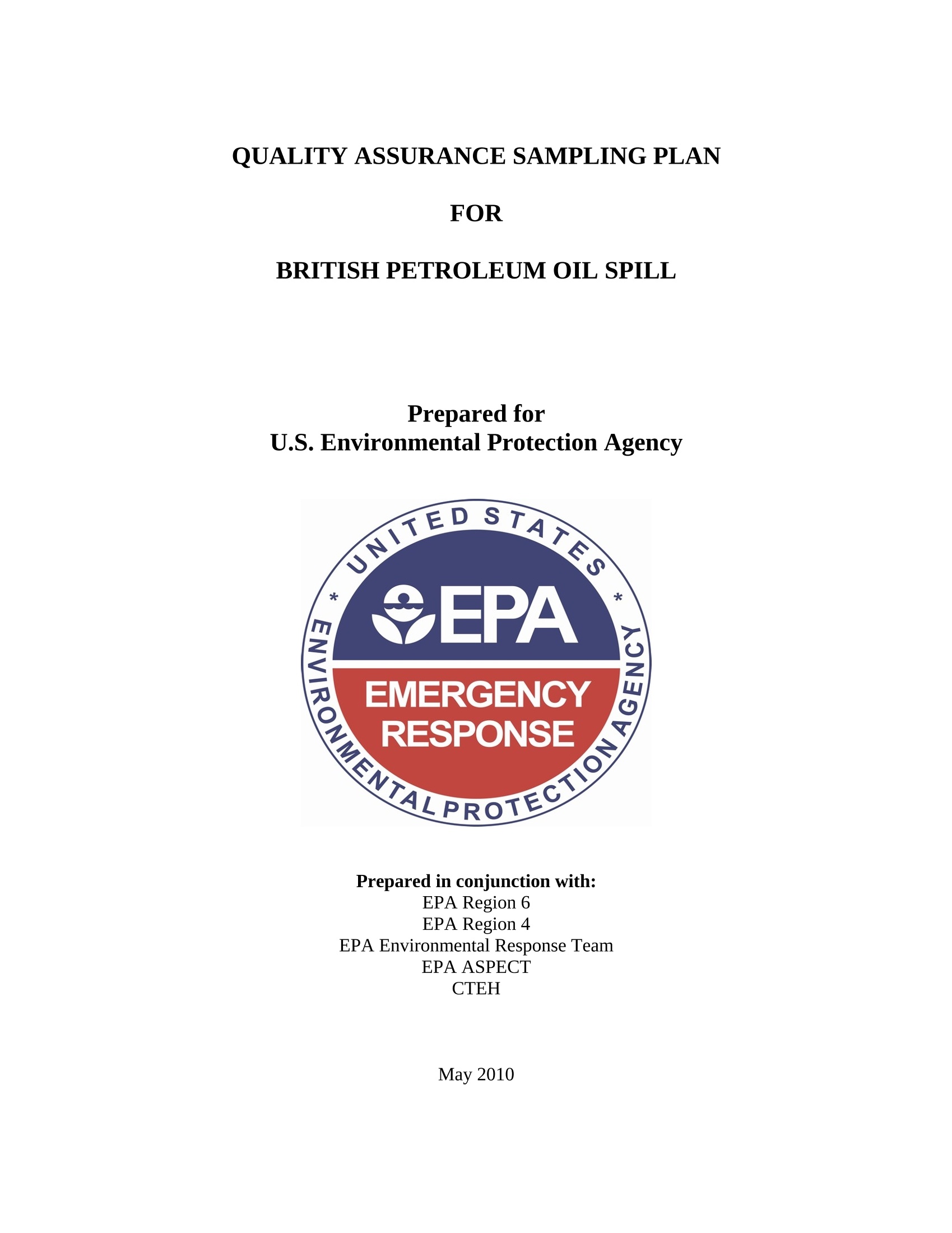
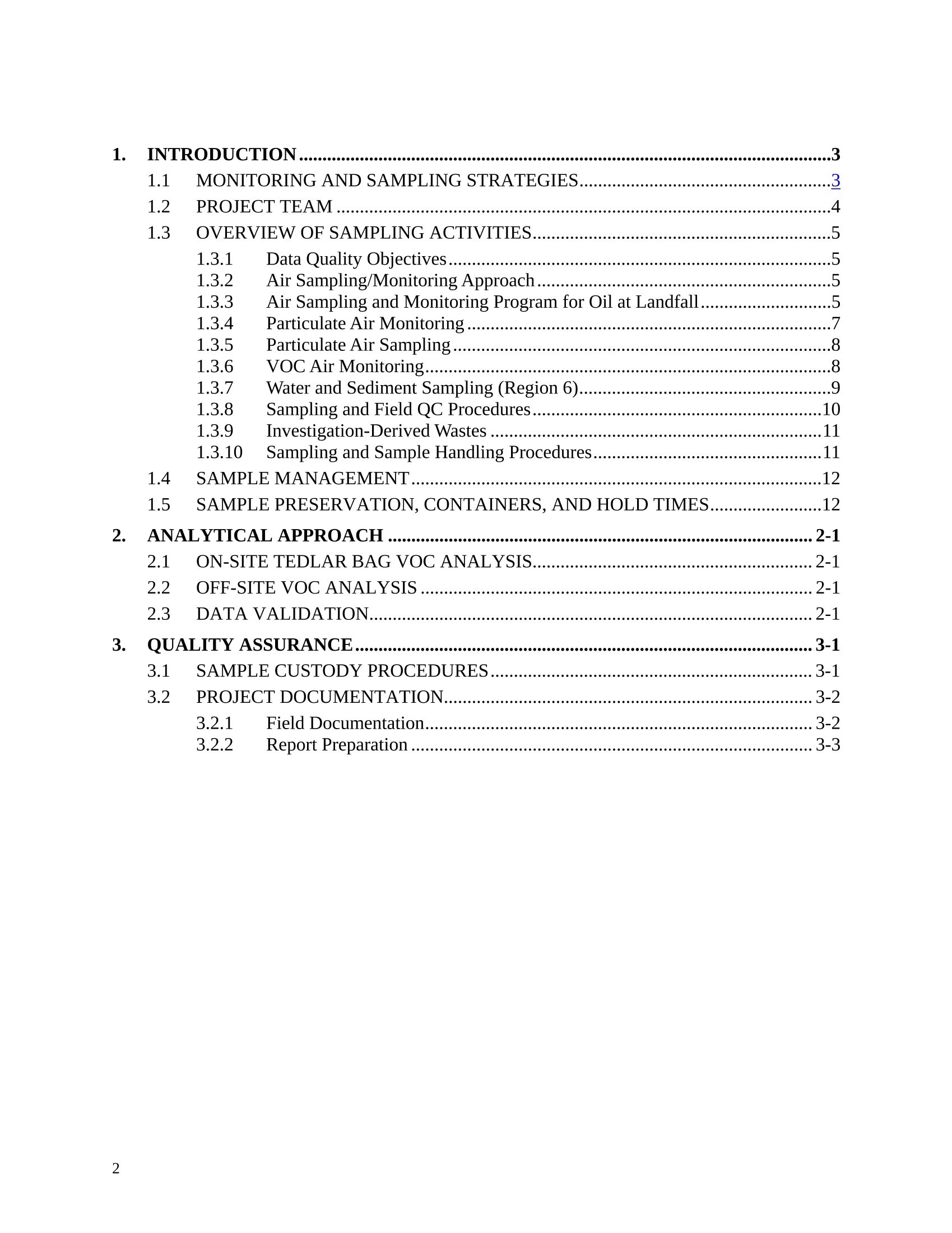

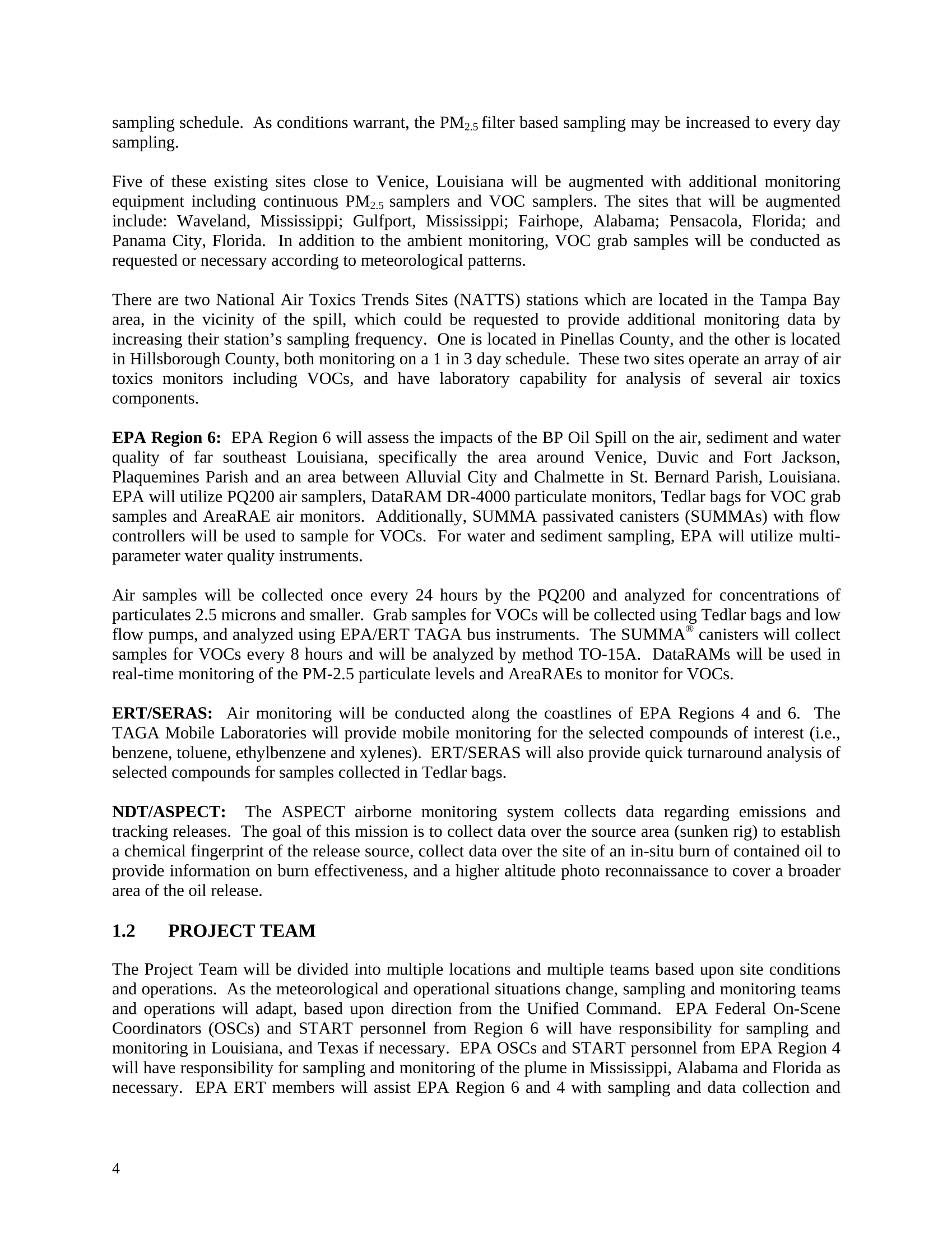
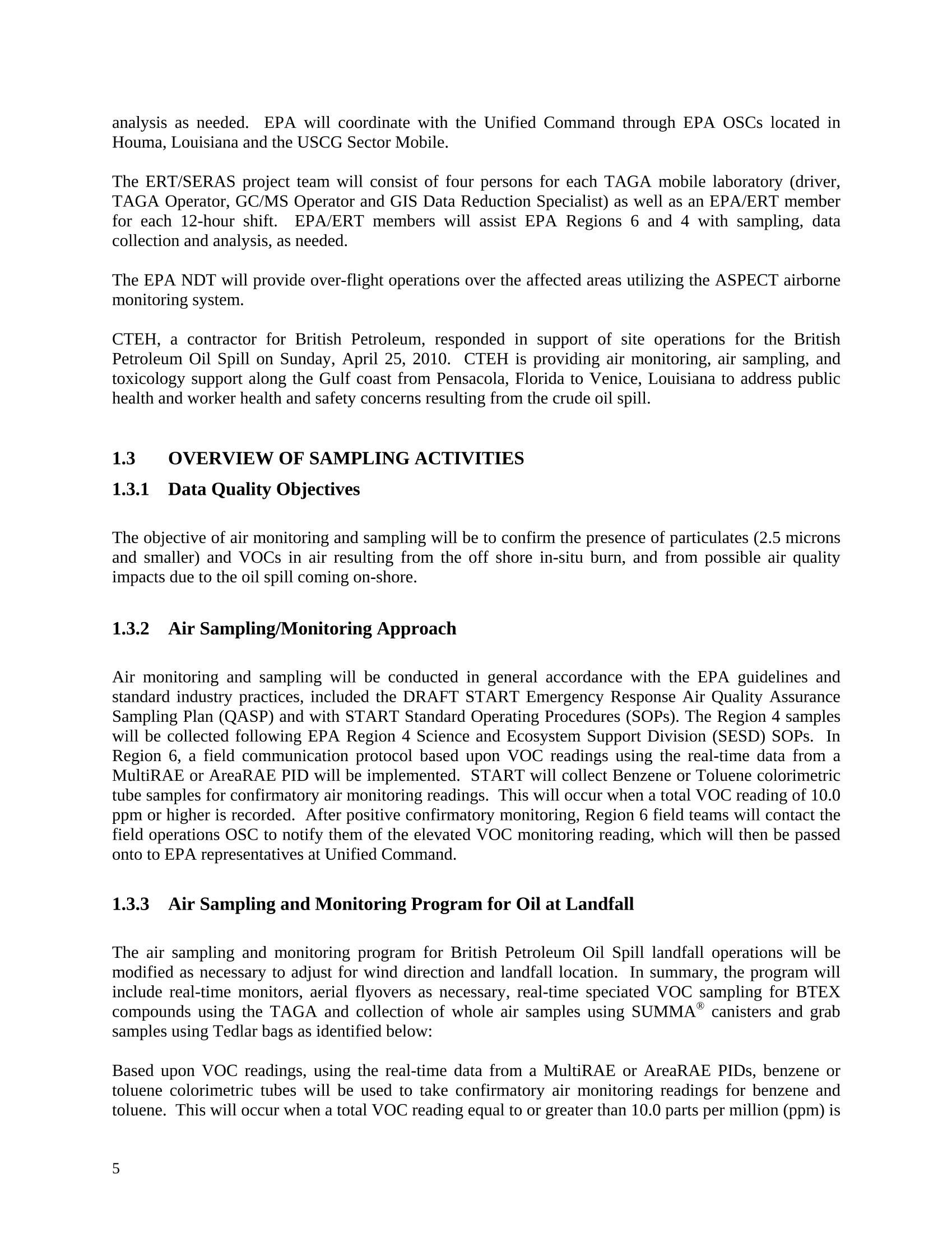
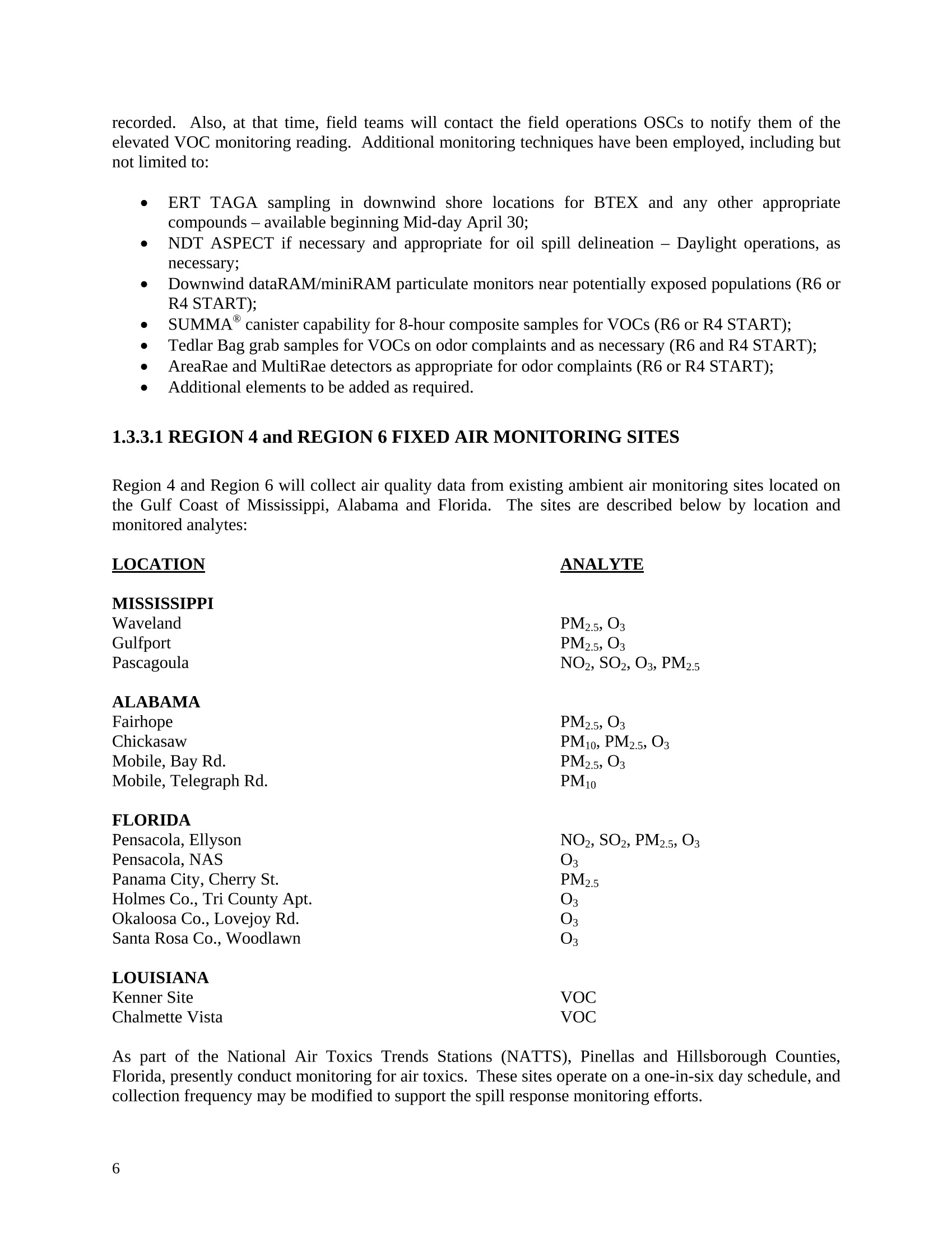
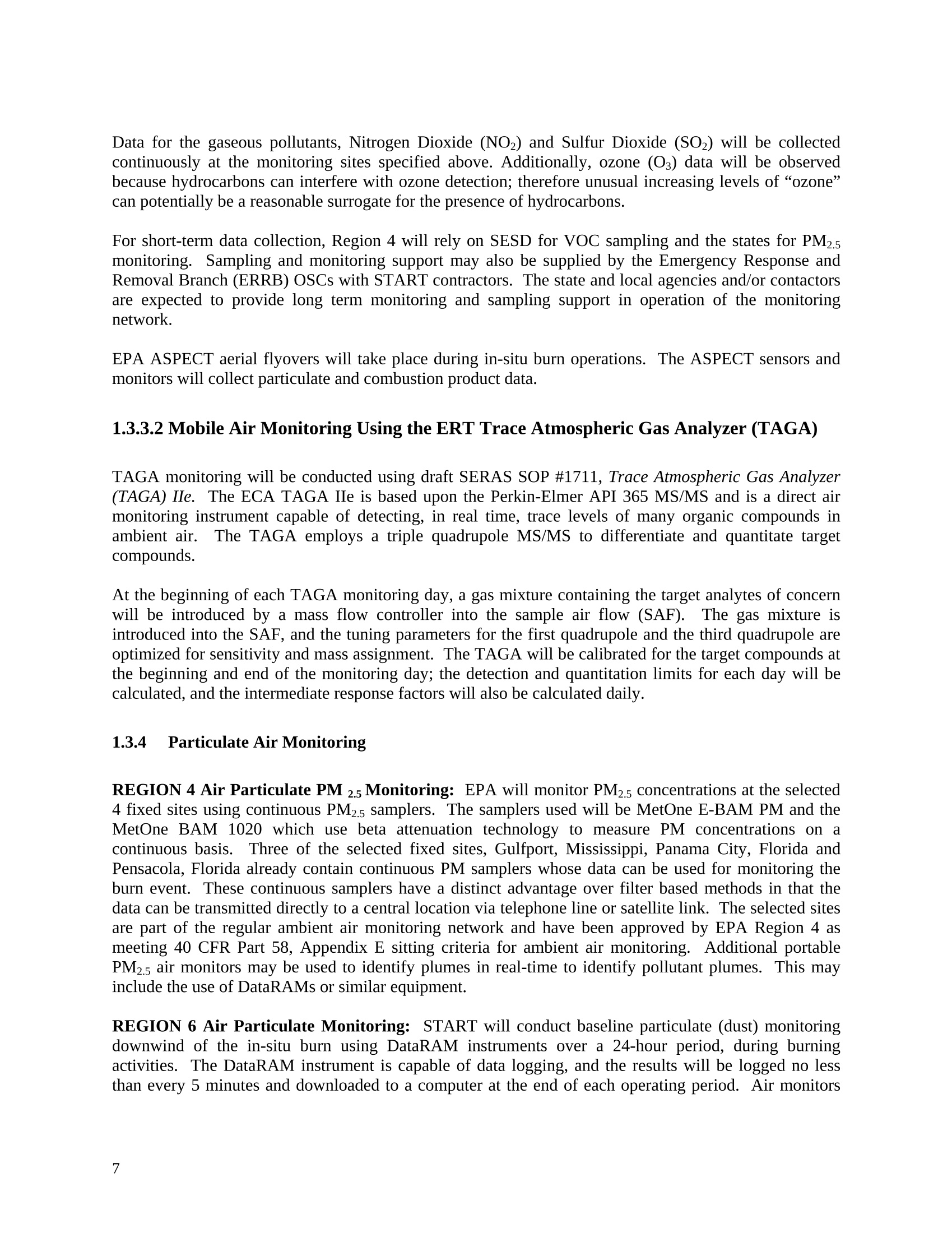
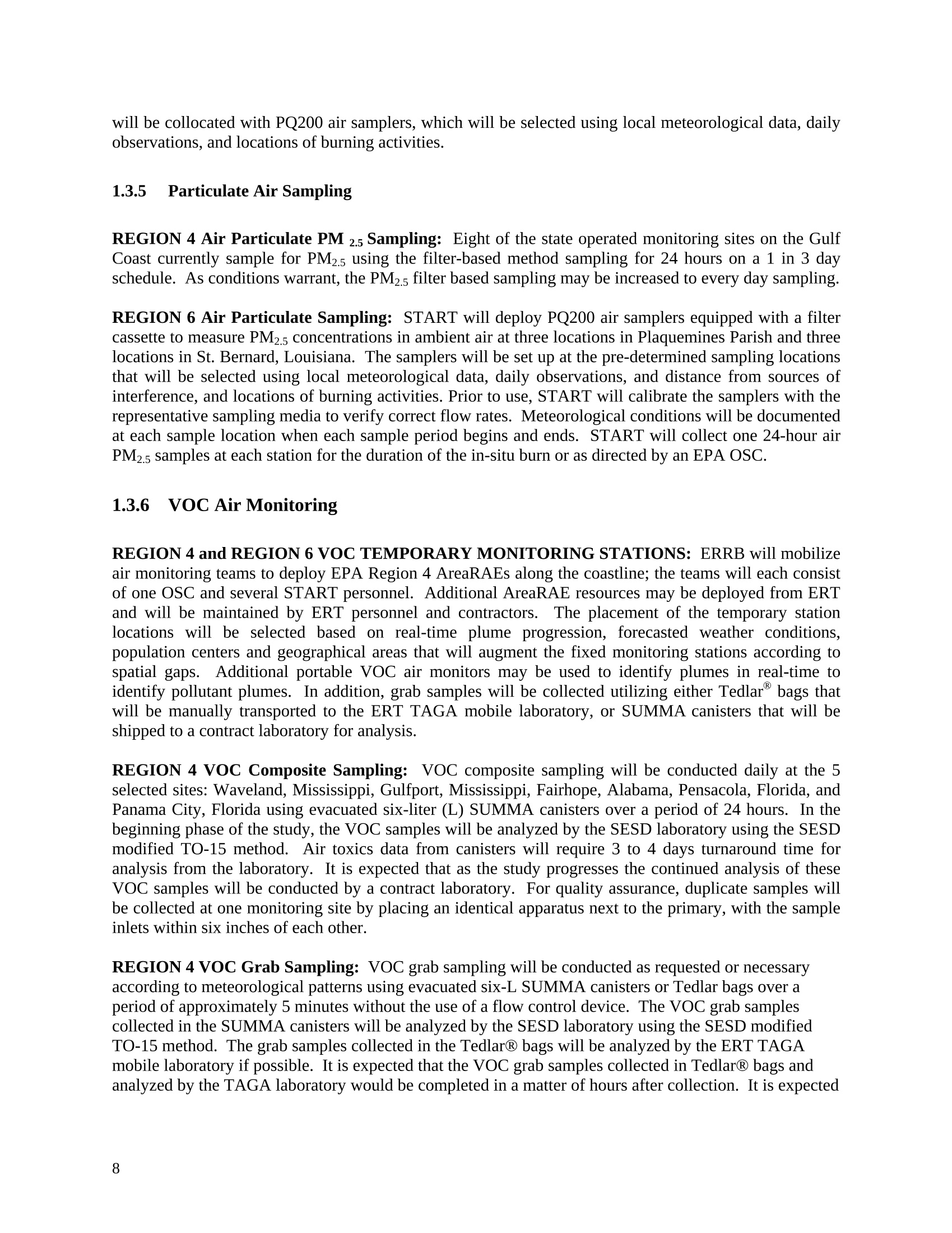
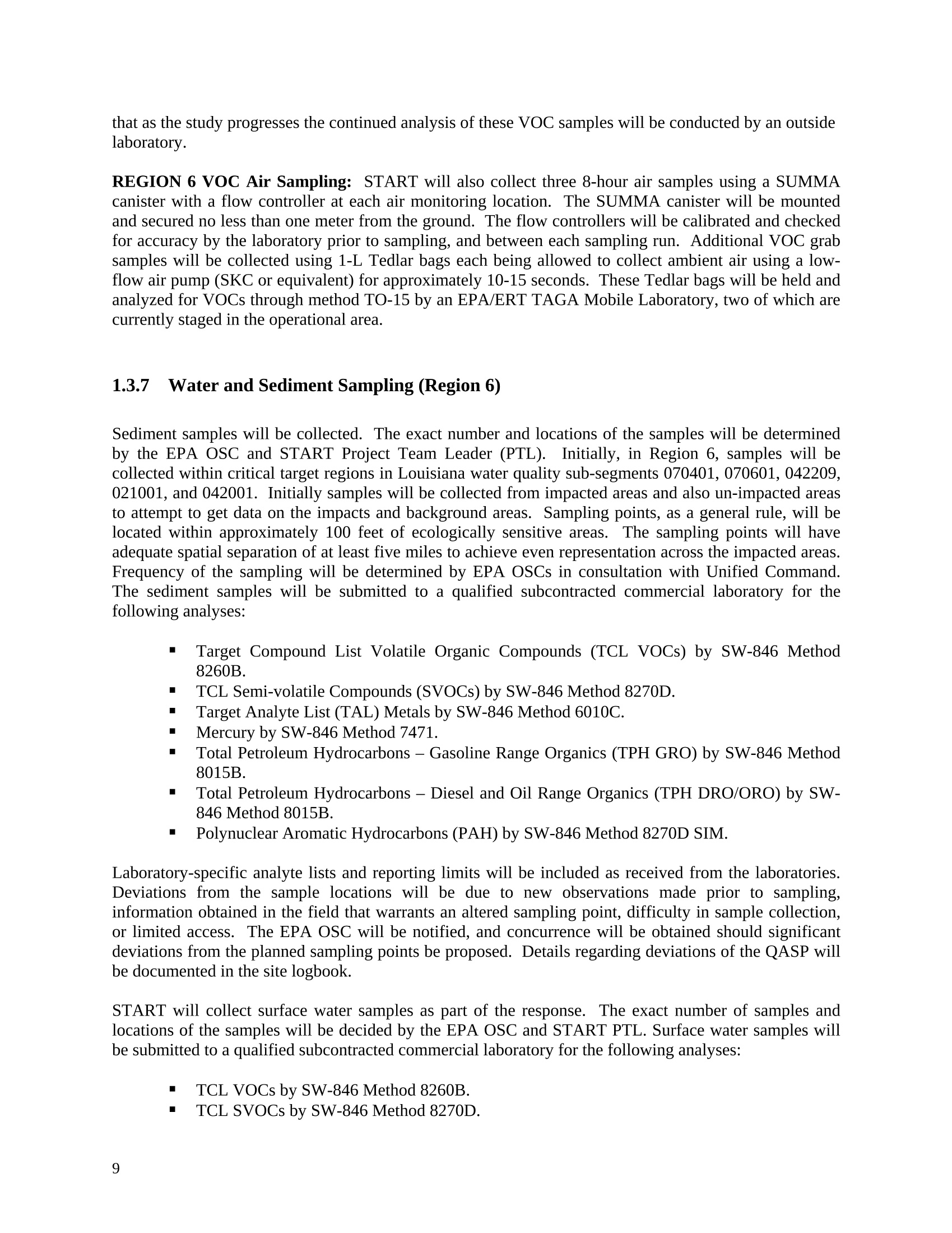
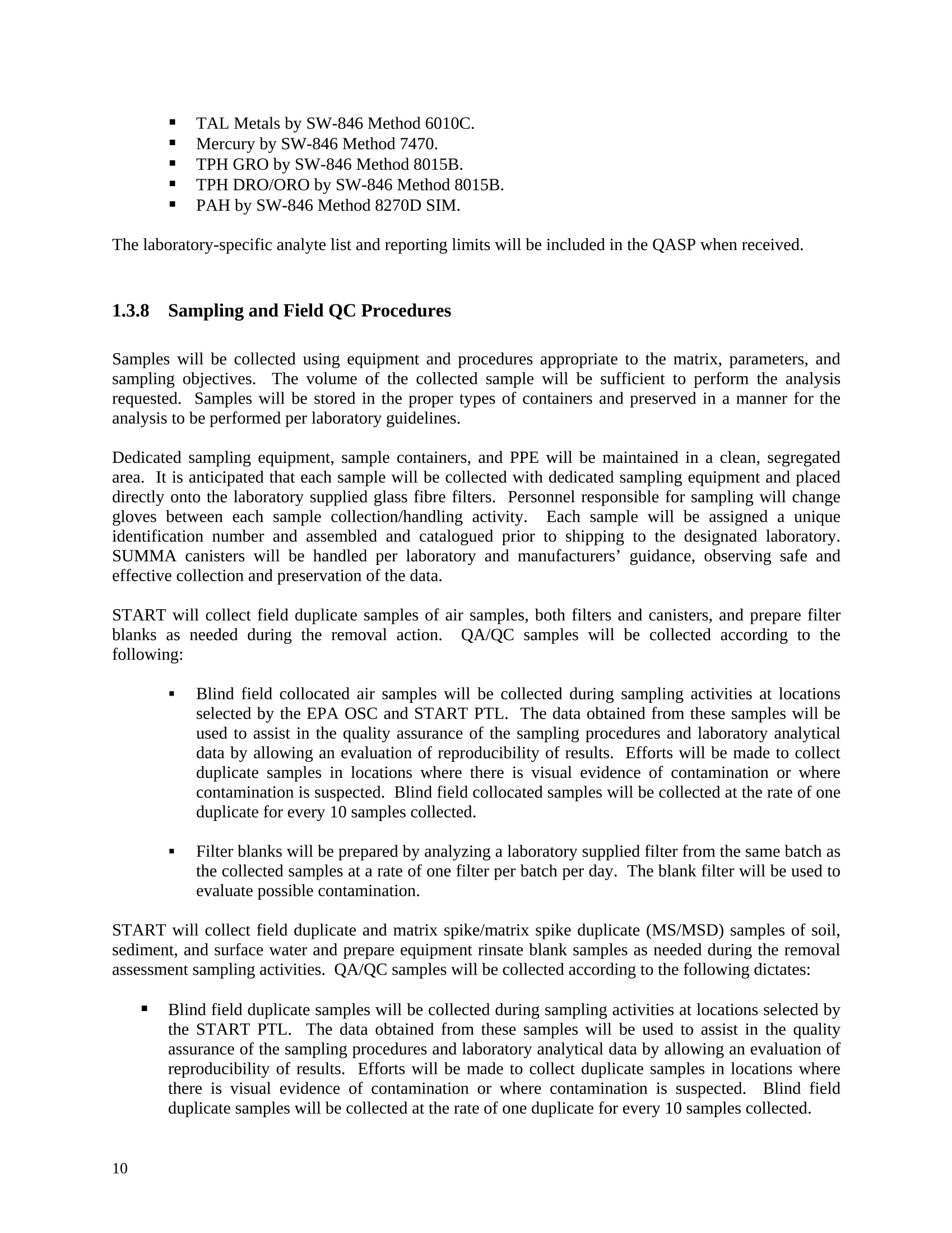
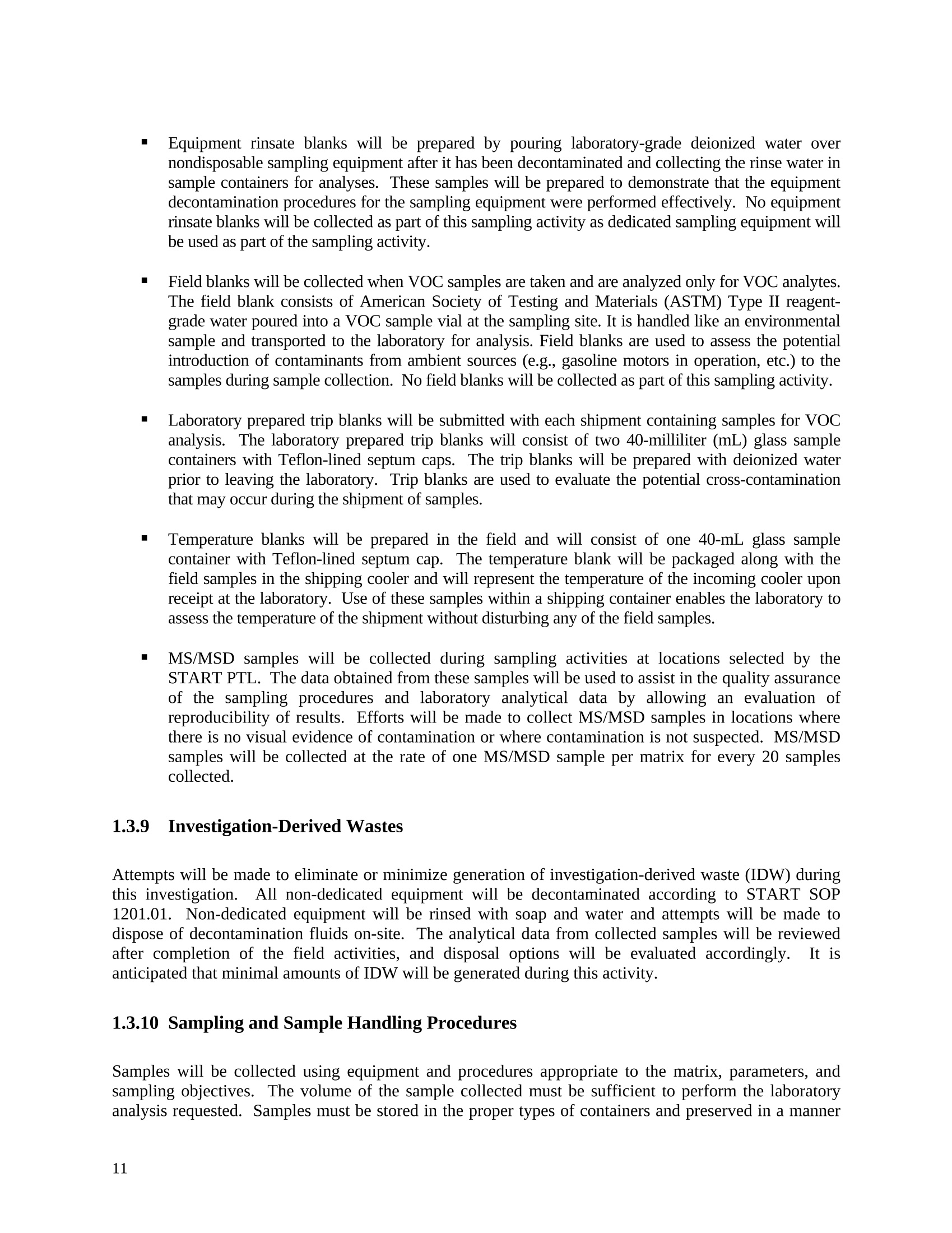
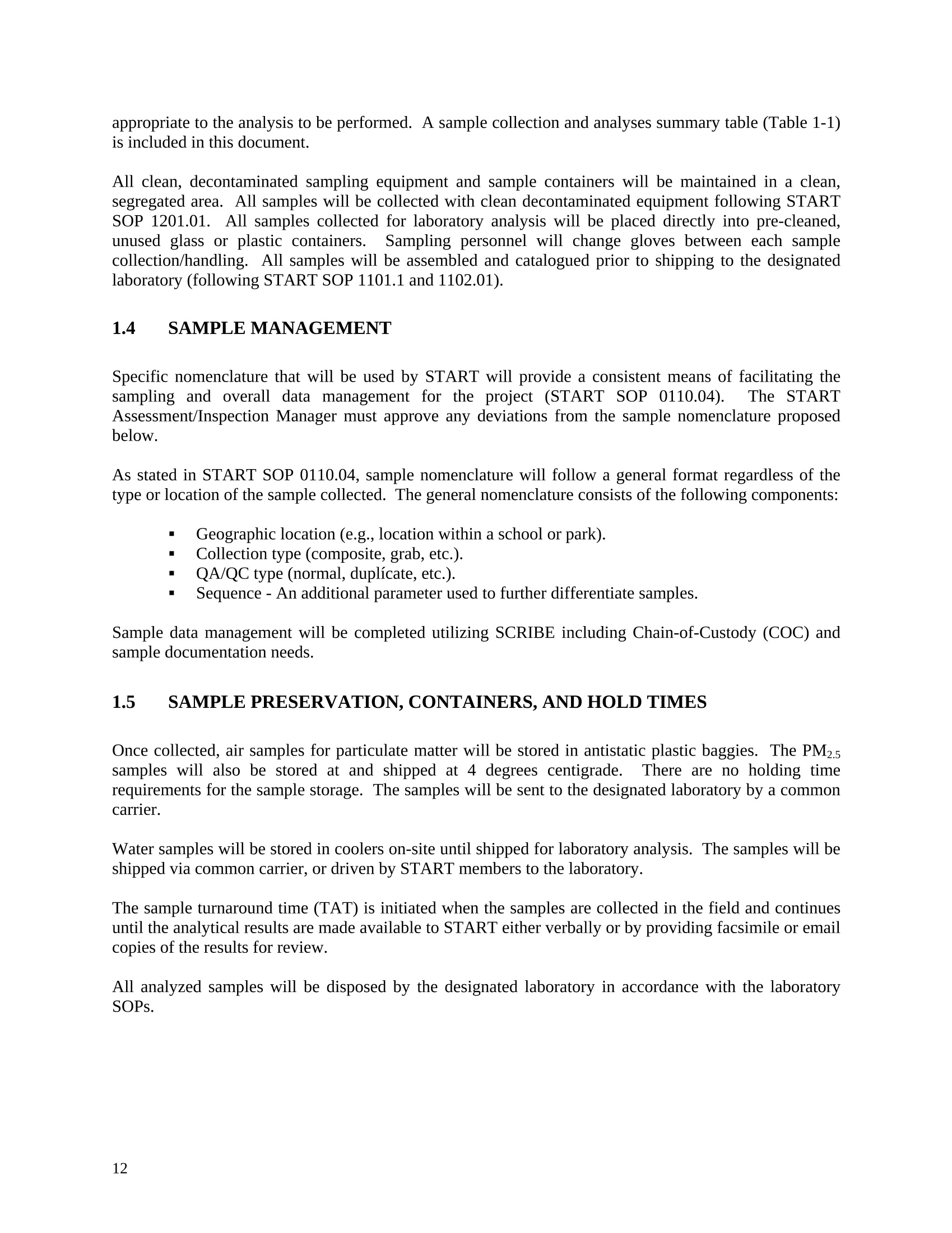
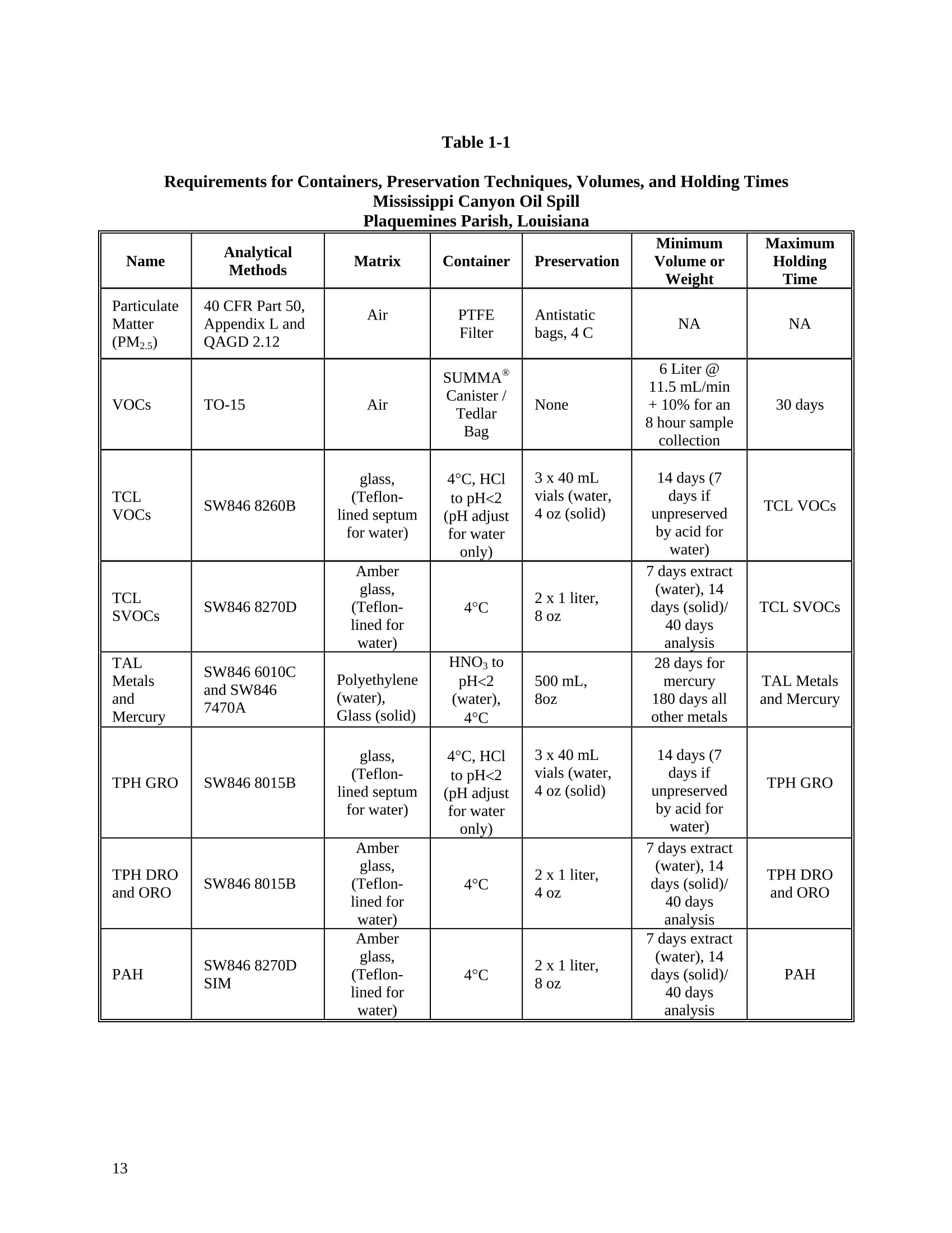
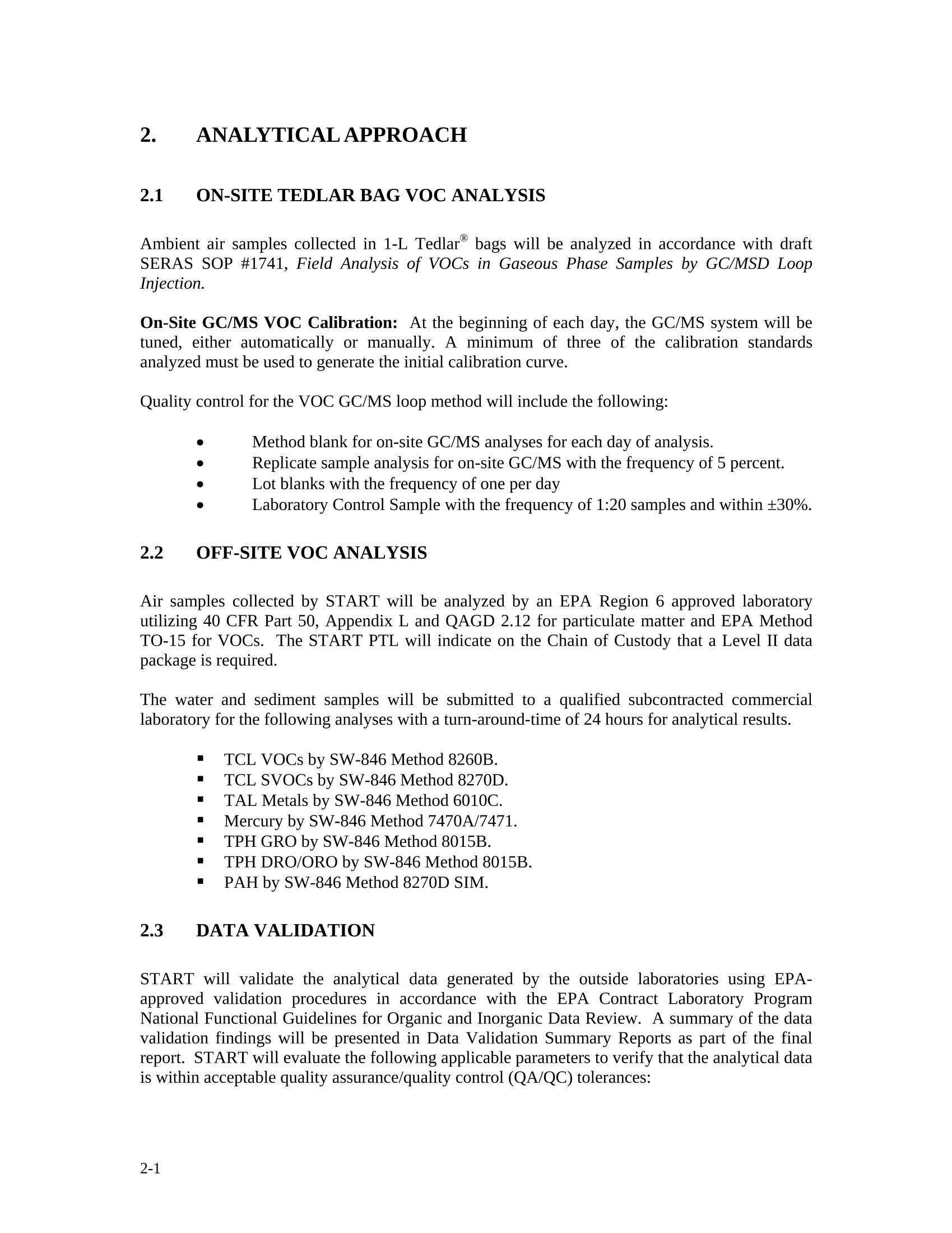
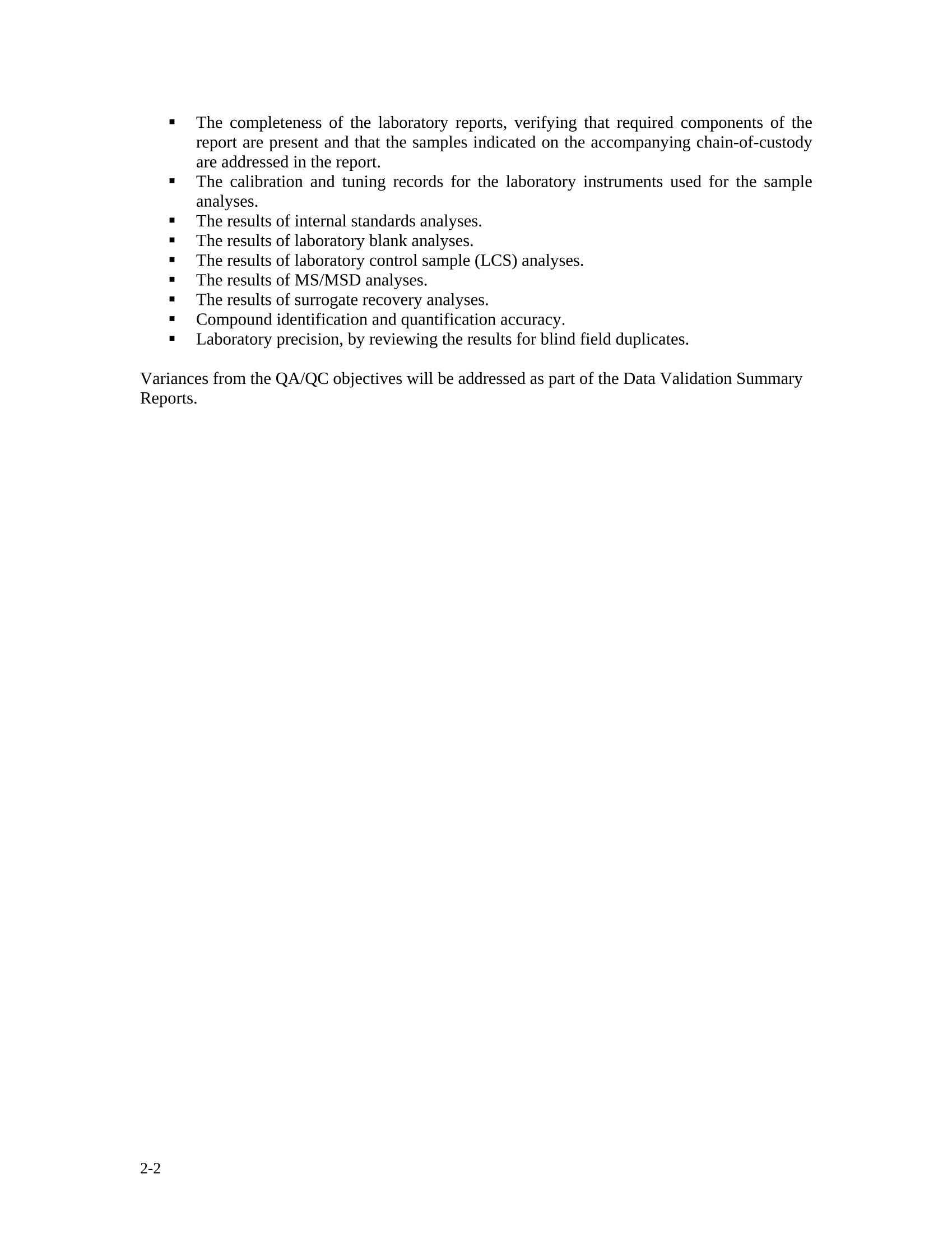
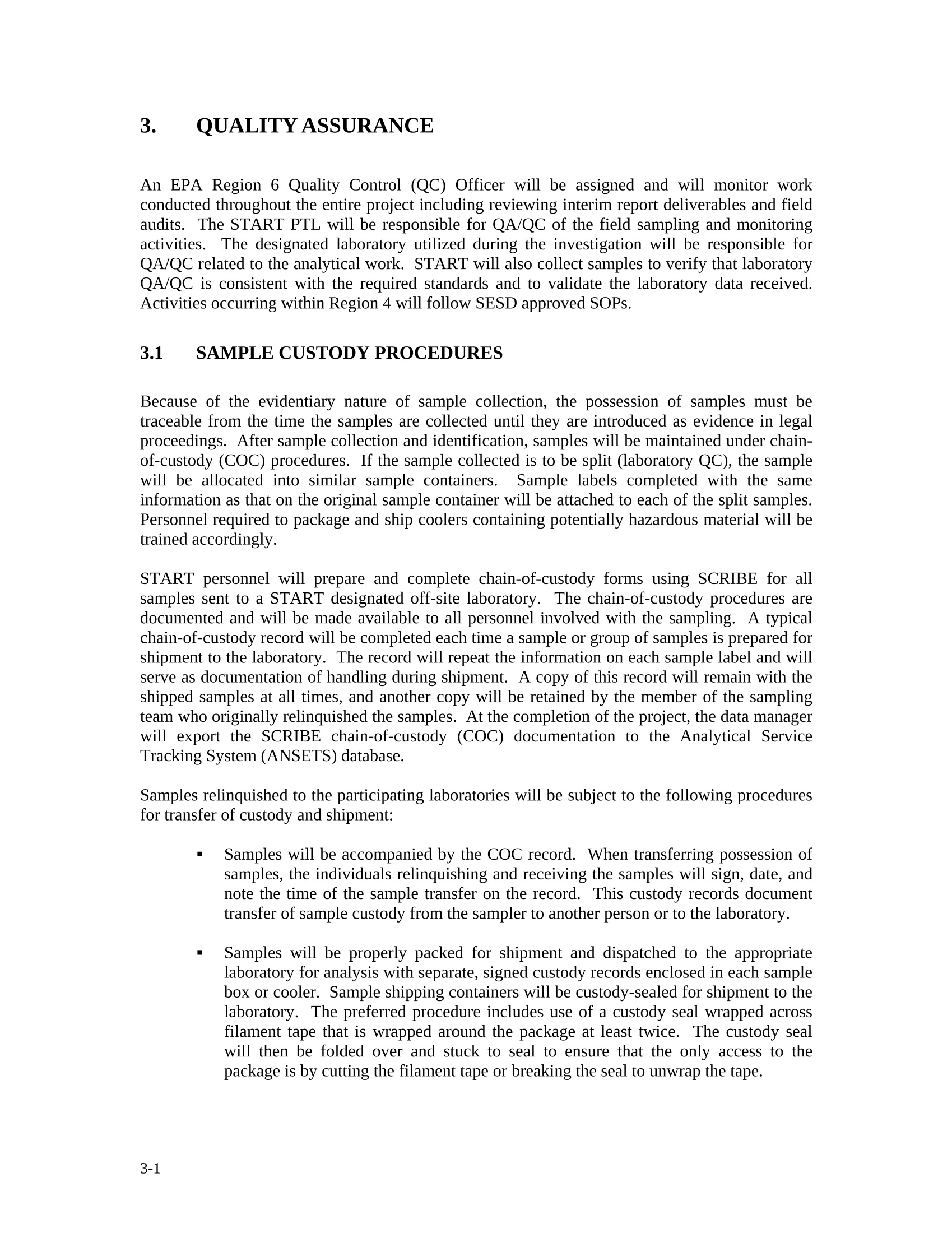
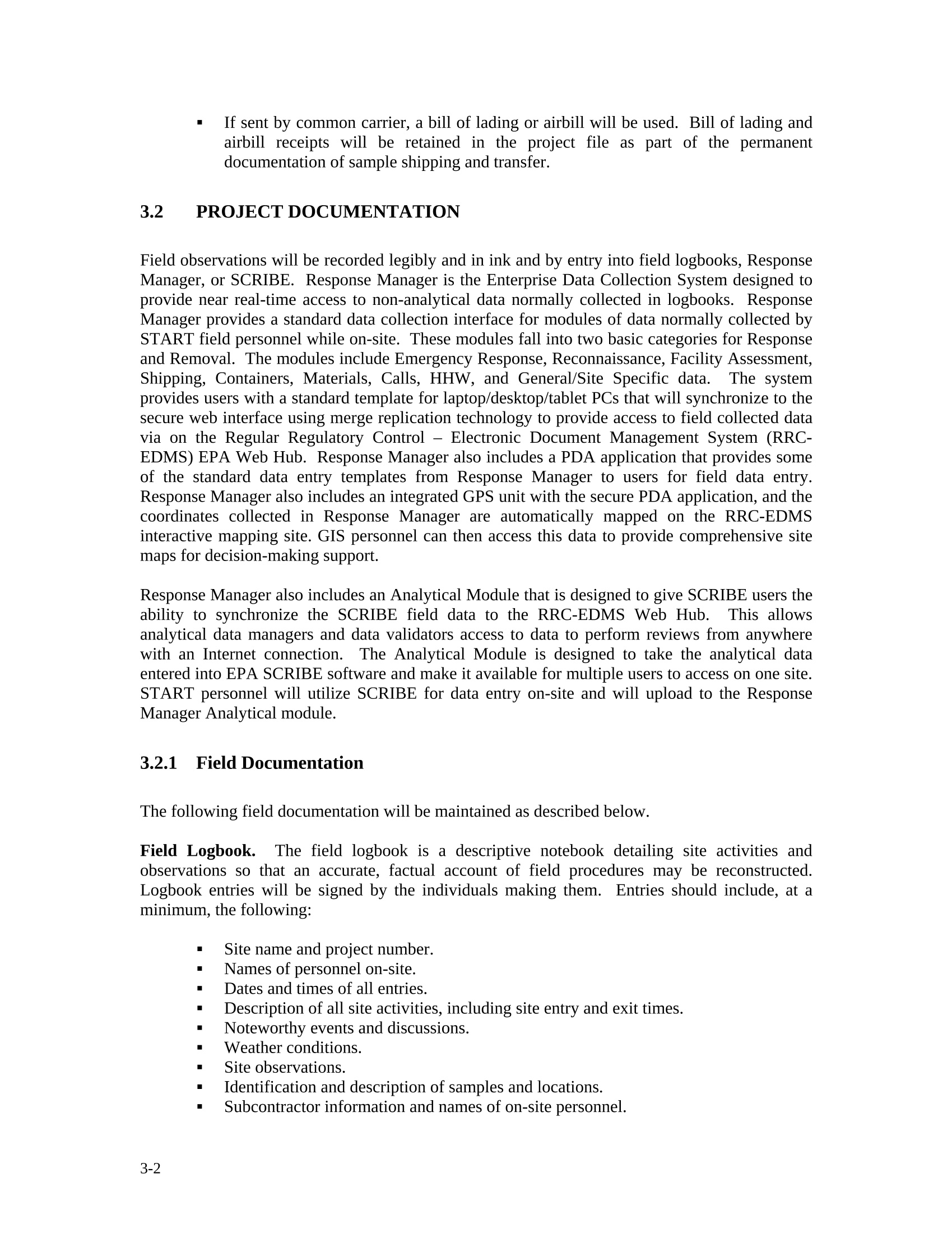
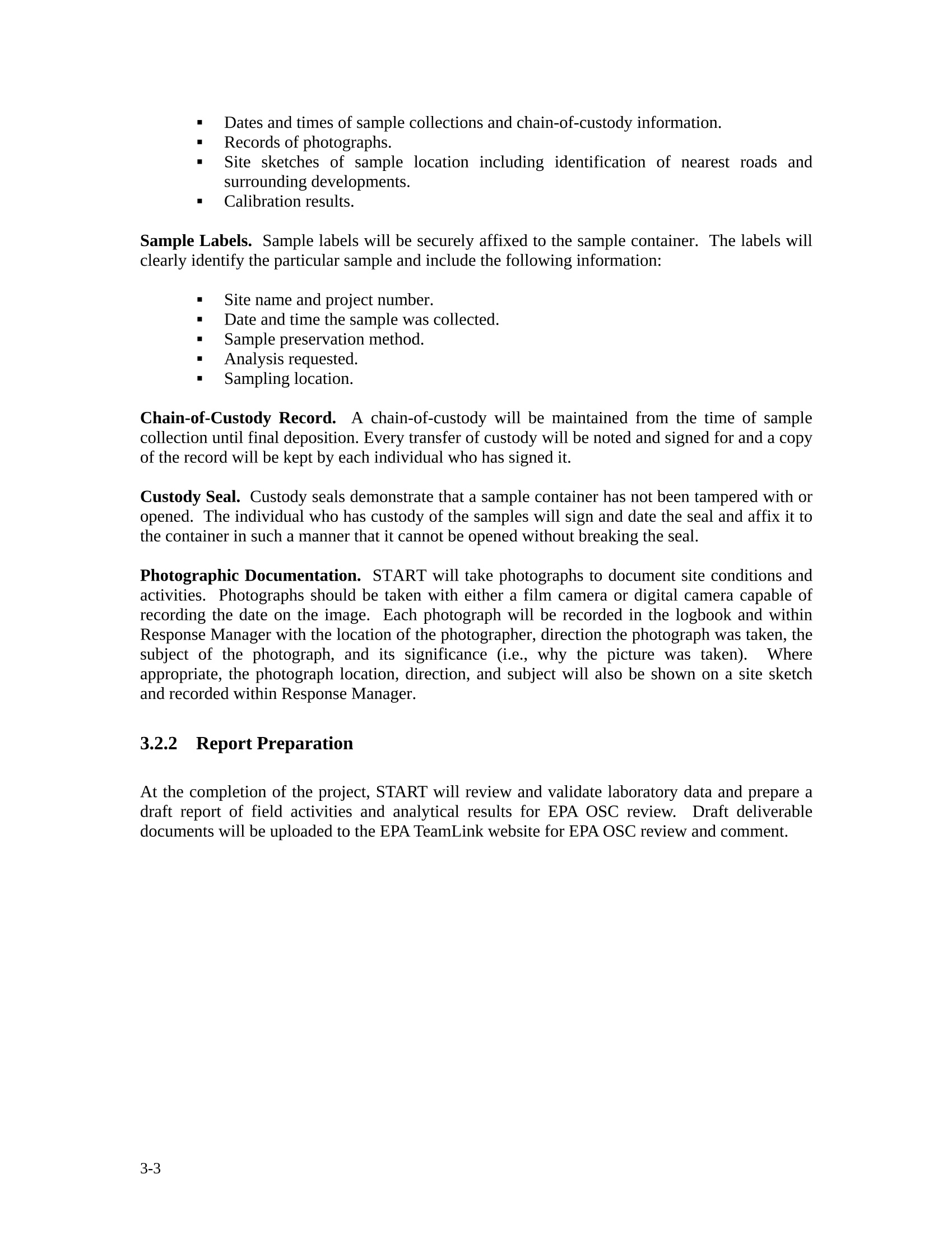
还剩16页未读,是否继续阅读?
北京赛克玛环保仪器有限公司为您提供《空气中颗粒物检测方案 》,该方案主要用于空气中综合检测,参考标准--,《空气中颗粒物检测方案 》用到的仪器有
相关方案
更多








